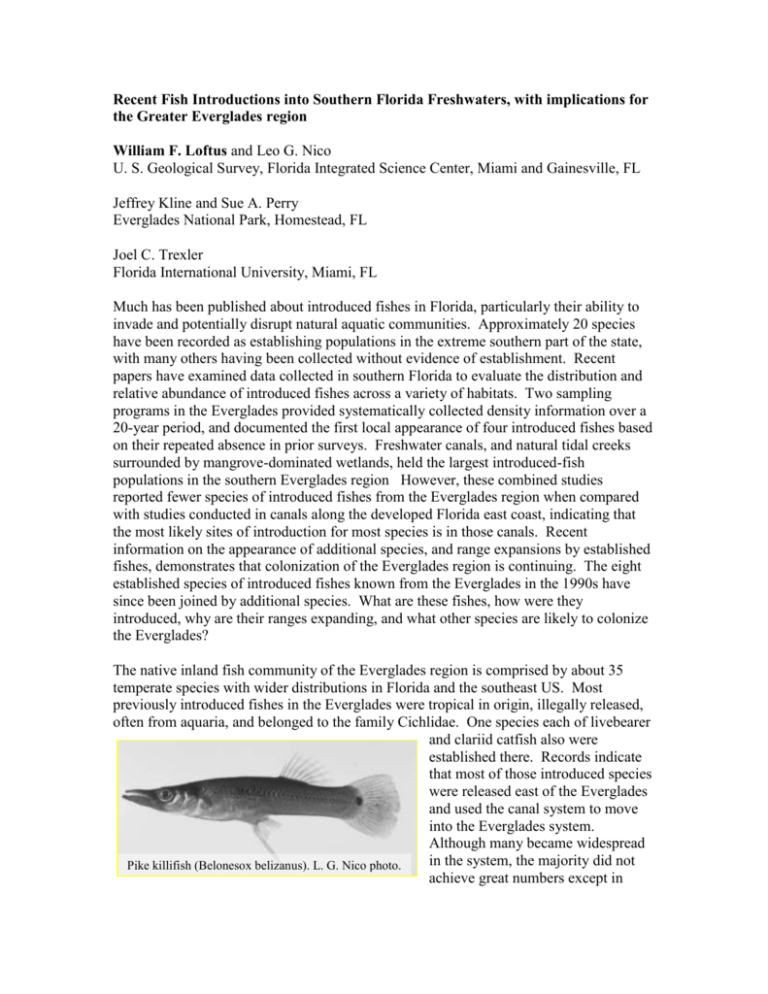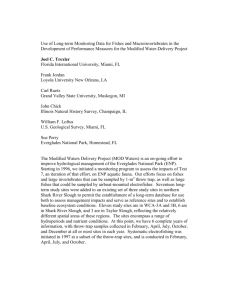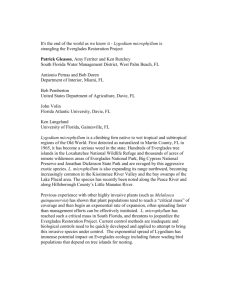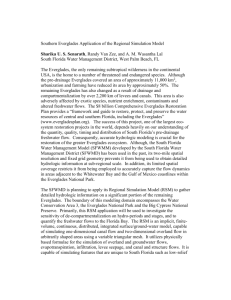Recent Fish Introductions into Southern Florida Freshwaters, with
advertisement

Recent Fish Introductions into Southern Florida Freshwaters, with implications for the Greater Everglades region William F. Loftus and Leo G. Nico U. S. Geological Survey, Florida Integrated Science Center, Miami and Gainesville, FL Jeffrey Kline and Sue A. Perry Everglades National Park, Homestead, FL Joel C. Trexler Florida International University, Miami, FL Much has been published about introduced fishes in Florida, particularly their ability to invade and potentially disrupt natural aquatic communities. Approximately 20 species have been recorded as establishing populations in the extreme southern part of the state, with many others having been collected without evidence of establishment. Recent papers have examined data collected in southern Florida to evaluate the distribution and relative abundance of introduced fishes across a variety of habitats. Two sampling programs in the Everglades provided systematically collected density information over a 20-year period, and documented the first local appearance of four introduced fishes based on their repeated absence in prior surveys. Freshwater canals, and natural tidal creeks surrounded by mangrove-dominated wetlands, held the largest introduced-fish populations in the southern Everglades region However, these combined studies reported fewer species of introduced fishes from the Everglades region when compared with studies conducted in canals along the developed Florida east coast, indicating that the most likely sites of introduction for most species is in those canals. Recent information on the appearance of additional species, and range expansions by established fishes, demonstrates that colonization of the Everglades region is continuing. The eight established species of introduced fishes known from the Everglades in the 1990s have since been joined by additional species. What are these fishes, how were they introduced, why are their ranges expanding, and what other species are likely to colonize the Everglades? The native inland fish community of the Everglades region is comprised by about 35 temperate species with wider distributions in Florida and the southeast US. Most previously introduced fishes in the Everglades were tropical in origin, illegally released, often from aquaria, and belonged to the family Cichlidae. One species each of livebearer and clariid catfish also were established there. Records indicate that most of those introduced species were released east of the Everglades and used the canal system to move into the Everglades system. Although many became widespread in the system, the majority did not Pike killifish (Belonesox belizanus). L. G. Nico photo. achieve great numbers except in local situations. We hypothesize that a combination of cold winter temperatures and unfavorable habitat structure may have limited success in natural habitats by some previously established species. Several widespread sampling programs employing electrofishing, trapping, and netting, and shorterterm research studies, continue to provide information on introduced species in the Everglades region. Those studies, and ongoing ichthyofaunal surveys of the Big Pike Killifish (Photo: Leo Nico) Cypress NP and Biscayne NP, are continuing to collect data from canals, marshes, swamps, and detention areas. In recent years, several new species have been collected either in the Everglades or in canals that border the system. Although several are cichlids (jewelfish, banded severum, jaguar cichlid, peacock bass), others belong to families not formerly found in this region (Asian swamp eel-Homestead population, armored catfishes). In addition, other species are established in the canal system to the east, from which dispersal towards the Everglades is likely (Asian swamp eel – Miami population, snakehead, grass carp, various cichlids). While some of these recent introductions are probably aquarium releases, others appear to be illegal introductions for food or marketing purposes. Apart from the accidental release of blue tilapia from a Miami-Dade County aquaculture facility, this class of foodfish planting by amateurs is a novel vector for fish introduction. Analysis of Everglades data collections Asian Swamp Eel (L. G. Nico Photo) found evidence for mainly local effects by introduced fishes, but the long-term effects of introductions, particularly with the continuing accumulation of species, are unclear. Experimental research into the biotic interactions of introduced fishes and native species is needed, as is modeling research to identify species that may pose problems if they were to be introduced. There should be emphasis placed on additional monitoring of under-sampled habitats such as canals. We also suggest that more efforts be made to educate the public about introduced species and in closing newly identified pathways for the introduction of additional species identified as potential threats. Although there have been no dramatic ecosystem effects such as extinctions or largescale population declines in native species identified in southern Florida, we are uncertain that this condition will continue under the cumulative effects of future invasions or environmental change. What can be done to limit the numbers, spread and effects of introduced fishes? At present, there are few options available to deal with introduced fishes in the open habitats of southern Florida. Once a population has expanded beyond its point of introduction into the main canal system or into the Everglades marsh, nothing can be done to eliminate or even control them at this time. Control may be effective in local situations to meet specific management objectives. Even then, it will have to be a sustained effort because of the pool of recruits that exists in the canal reservoirs. Unlike the research and management funding used to find and deliver controls for plant or insect pests, there has been little funding applied to research into controls for fishes. Increased emphasis on finding innovative methods for dealing with fish invaders should be a priority. At present, the best way to prevent the continuing introduction of fishes may be through better public education. We ask water managers and engineers to think of the consequences when planning pump stations, detention areas, new canals, and other constructs that will foster growth, dispersal, and delivery of non-native fishes, snails, and plants into natural wetland areas. Just “getting the water right” is not enough if it means the delivery of those waters will change the character of the Everglades biota. William, Loftus, 40001 State Road 9336, Homestead, Florida, 33034, Phone: 305-242-7835, Fax: 305-242-7836, Bill_Loftus@usgs.gov •Heavy predation of small native species in drying pools, solution holes, and canals ••Native fish nest predation and displacement







